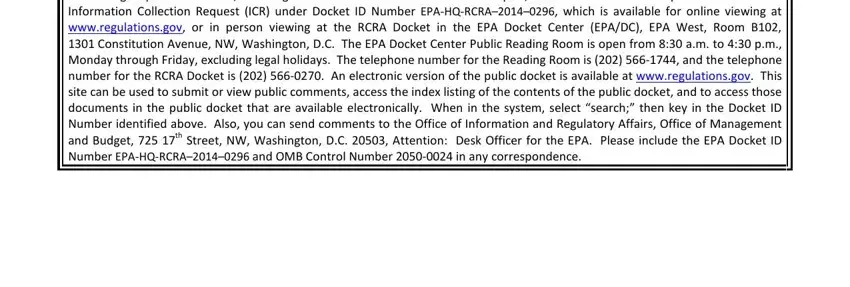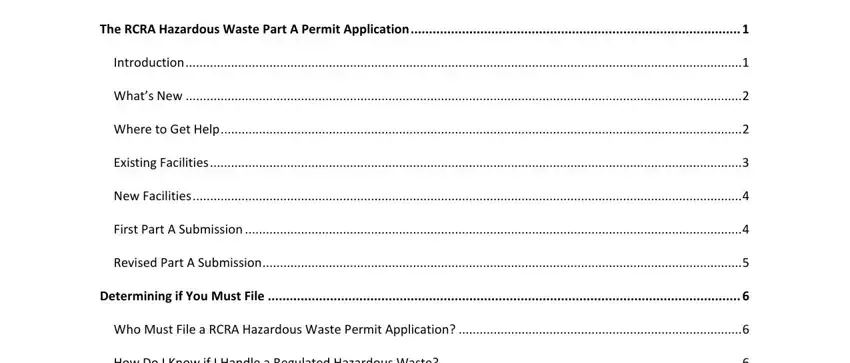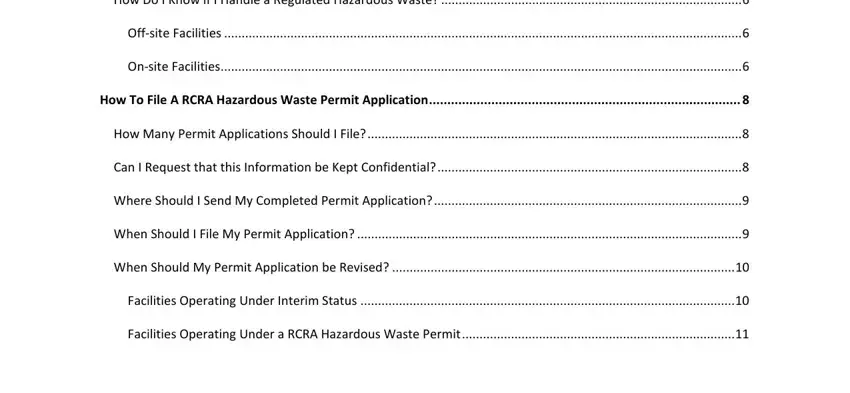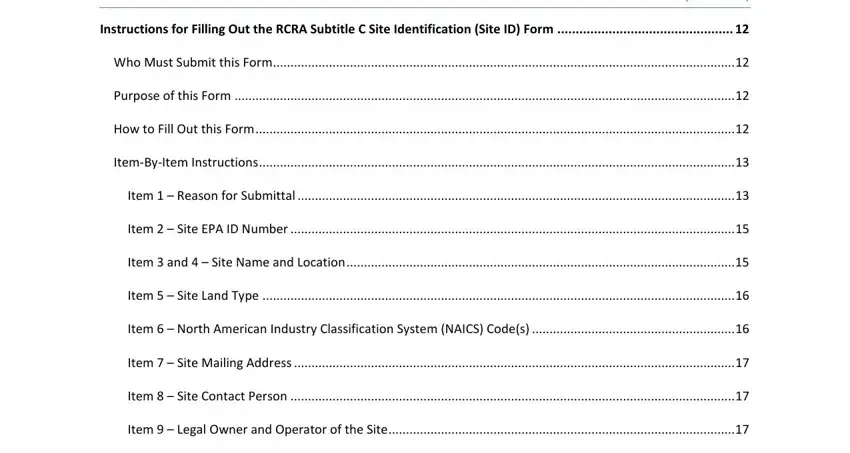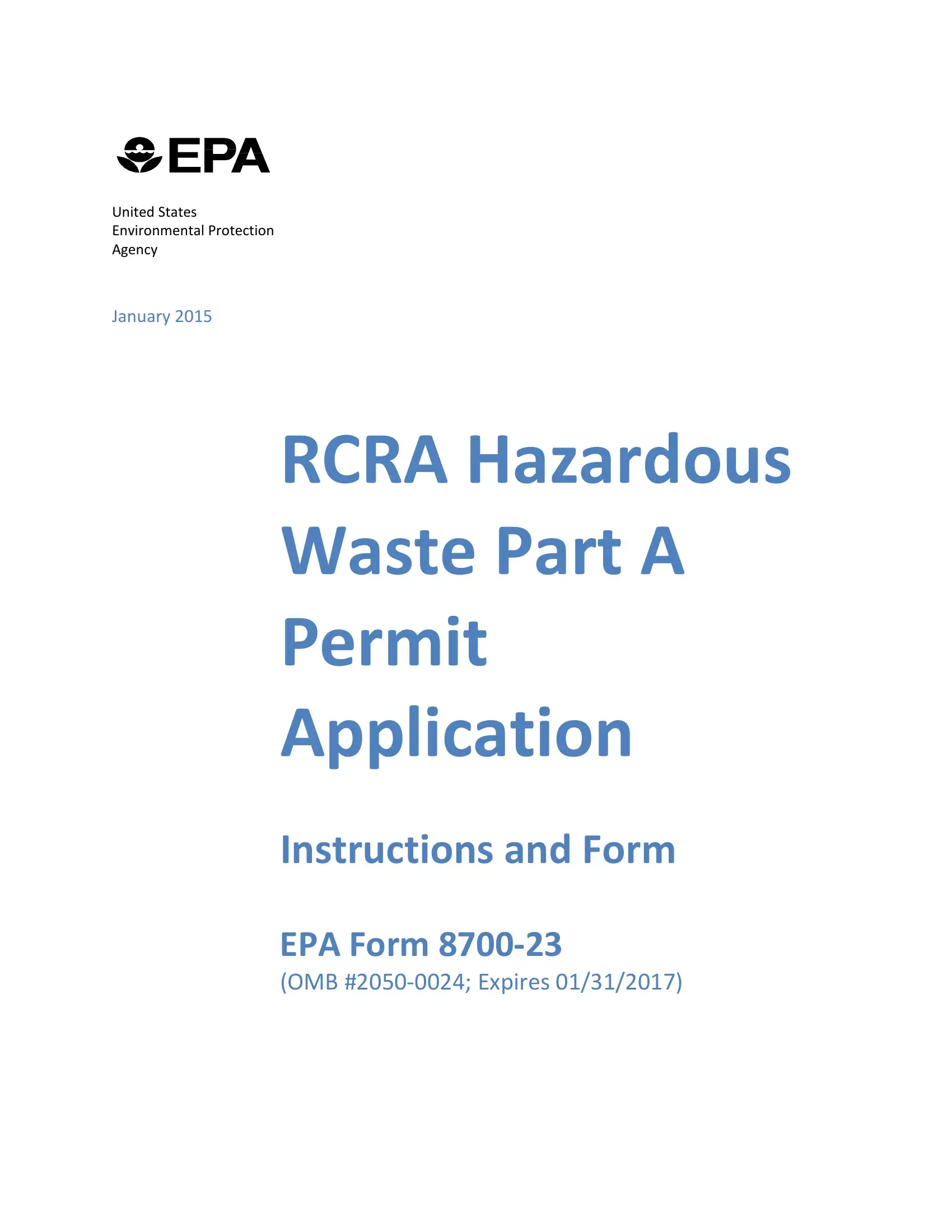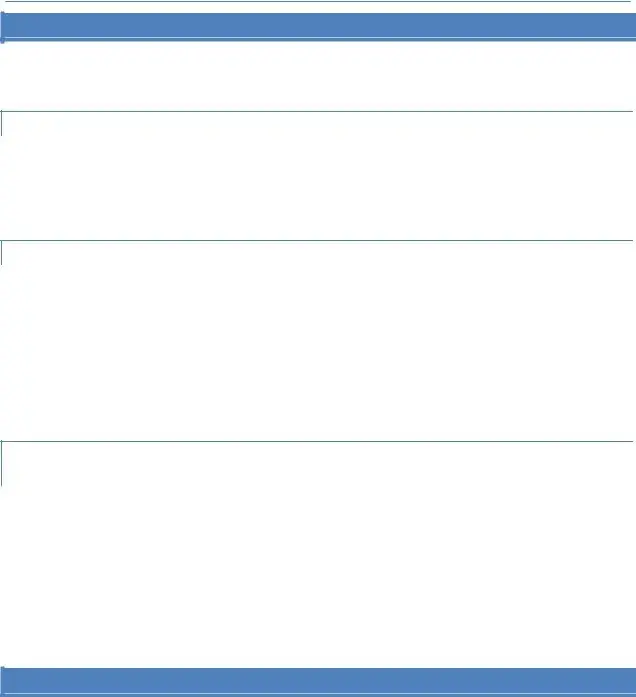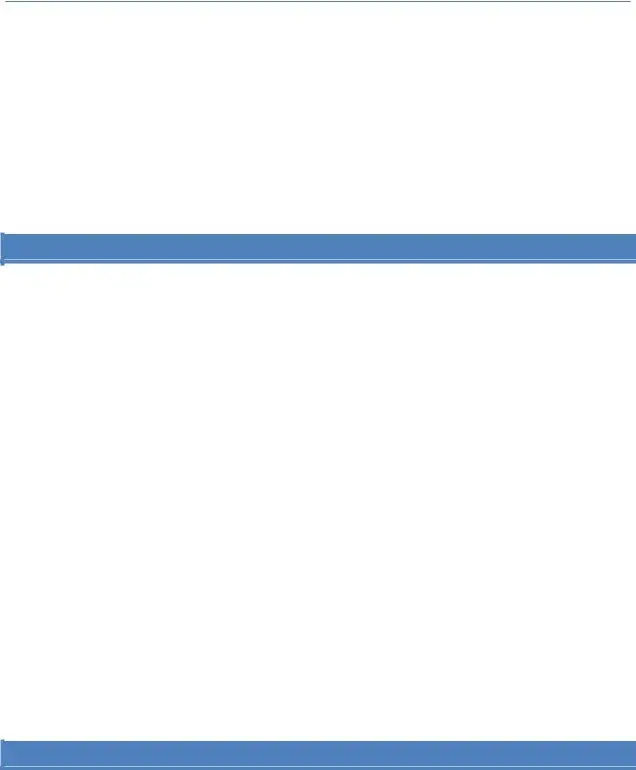United States
Environmental Protection
Agency
January 2015
RCRA Hazardous
Waste Part A
Permit
Application
Instructions and Form
EPA Form 8700-23
(OMB #2050-0024; Expires 01/31/2017)
Office of Resource Conservation and Recovery (ORCR) (5303P)
Washington, DC 20460
RCRA Hazardous Waste Part A Permit Application
Instructions and Form
The Resource Conservation and Recovery Act (RCRA) Section 3005 requires the U.S. Environmental Protection Agency (EPA) to establish permitting requirements applicable to hazardous waste treatment, storage, or disposal facilities (TSDFs). The owner and operator of a TSDF must obtain a permit as required under 40 CFR Part 270. Respondents must submit the information required in the RCRA Hazardous Waste Part A Permit Application [EPA Form 8700-23] (Part A Permit Application) for a first permit application or for a revised permit application. Owners and operators of four types of TSDFs are subject to the requirements: new facilities not yet constructed; newly regulated existing facilities subject to RCRA permitting requirements for the first time; permitted facilities with newly regulated units; and interim status facilities. The EPA needs information contained in the application to identify the person(s) legally responsible for hazardous waste activity, to determine which facilities require permits under more than one program, to assess potential for the facility to pollute nearby ground and surface waters, to identify the timeframe available for the EPA to process permit applications, and to determine the specific wastes a facility is legally allowed to handle for different purposes. The EPA must ensure that hazardous wastes are managed in a way that protects human health and the environment as required by RCRA. This is mandatory reporting by the respondents.
The EPA enters Part A Permit Application information submitted by respondents into RCRAInfo, the EPA national database, and issues permits. The EPA uses this information to identify the universe of regulated waste TSDFs and their specific regulated hazardous waste activities. The EPA also uses the information for tracking and planning and for a variety of enforcement and inspection purposes. Finally, the EPA uses this information to ensure that: hazardous wastes are managed properly; TSDFs are operated and maintained as required; statutory provisions are upheld; and that regulations are adhered to by facility owners and operators.
Section 3007(b) of RCRA and 40 CFR Part 2, Subpart B, which defines the EPA’s general policy on public disclosure of information, both contain provisions for confidentiality. However, the Agency does not anticipate that businesses will assert a claim of confidentiality covering all or part of the Part A Permit Application. If such a claim were asserted, the EPA must and will treat the information in accordance with the regulations cited above. The EPA also will assure that the information collection complies with the Privacy Act of 1974 and OMB Circular 108.
Estimated Burden: Facilities - The reporting burden associated with the Part A Permit Application requirements is estimated to average 12 hours for a facility to prepare and submit a new or revised Part A Permit Application and associated documentation. The recordkeeping burden is estimated to average 4 hours for a facility to read the regulations. State Agencies - The reporting burden associated with the Part A Permit Application requirements is estimated to average 2 minutes for a State agency to notify an applicant of a deficiency in a new Part A Permit Application. The recordkeeping burden is estimated to average 5 hours for a State agency to review a new or revised Part A Permit Application and associated documentation, and enter the permit information into the RCRAInfo database.
To comment on the EPA’s need for this information, the accuracy of the provided burden estimates, and any suggested methods for minimizing respondent burden, including the use of automated collection techniques, the EPA has established a public docket for the Information Collection Request (ICR) under Docket ID Number EPA-HQ-RCRA–2014–0296, which is available for online viewing at www.regulations.gov, or in person viewing at the RCRA Docket in the EPA Docket Center (EPA/DC), EPA West, Room B102, 1301 Constitution Avenue, NW, Washington, D.C. The EPA Docket Center Public Reading Room is open from 8:30 a.m. to 4:30 p.m., Monday through Friday, excluding legal holidays. The telephone number for the Reading Room is (202) 566-1744, and the telephone number for the RCRA Docket is (202) 566-0270. An electronic version of the public docket is available at www.regulations.gov. This site can be used to submit or view public comments, access the index listing of the contents of the public docket, and to access those documents in the public docket that are available electronically. When in the system, select “search;” then key in the Docket ID Number identified above. Also, you can send comments to the Office of Information and Regulatory Affairs, Office of Management and Budget, 725 17th Street, NW, Washington, D.C. 20503, Attention: Desk Officer for the EPA. Please include the EPA Docket ID Number EPA-HQ-RCRA–2014–0296 and OMB Control Number 2050-0024 in any correspondence.
TABLE OF CONTENTS
(Note: This table of contents contains links (hyperlinks). To go to a particular section of the document,
move the cursor to the desired page number and left click on the computer mouse.)
The RCRA Hazardous Waste Part A Permit Application |
1 |
Introduction |
1 |
What’s New |
2 |
Where to Get Help |
2 |
Existing Facilities |
3 |
New Facilities |
4 |
First Part A Submission |
4 |
Revised Part A Submission |
5 |
Determining if You Must File |
6 |
Who Must File a RCRA Hazardous Waste Permit Application? |
6 |
How Do I Know if I Handle a Regulated Hazardous Waste? |
6 |
Off-site Facilities |
6 |
On-site Facilities |
6 |
How To File A RCRA Hazardous Waste Permit Application |
8 |
How Many Permit Applications Should I File? |
8 |
Can I Request that this Information be Kept Confidential? |
8 |
Where Should I Send My Completed Permit Application? |
9 |
When Should I File My Permit Application? |
9 |
When Should My Permit Application be Revised? |
10 |
Facilities Operating Under Interim Status |
10 |
Facilities Operating Under a RCRA Hazardous Waste Permit |
11 |
i

Table of Contents |
|
(continued) |
Instructions for Filling Out the RCRA Subtitle C Site Identification (Site ID) Form |
12 |
Who Must Submit this Form |
12 |
Purpose of this Form |
12 |
How to Fill Out this Form |
12 |
Item-By-Item Instructions |
13 |
Item 1 – Reason for Submittal |
13 |
Item 2 – Site EPA ID Number |
15 |
Item 3 and 4 – Site Name and Location |
15 |
Item 5 – Site Land Type |
16 |
Item 6 – North American Industry Classification System (NAICS) Code(s) |
16 |
Item 7 – Site Mailing Address |
17 |
Item 8 – Site Contact Person |
17 |
Item 9 – Legal Owner and Operator of the Site |
17 |
Item 10 – Type of Regulated Waste Activity |
19 |
Item 11 – Description of Hazardous Wastes |
27 |
Item 12 – Notification of Hazardous Secondary Material (HSM) Activity |
28 |
Item 13 – Comments |
28 |
Item 14 – Certification |
28 |
Addendum to the Site Identification Form: Notification of Hazardous Secondary Material Activity |
29 |
You Must Fill Out this Section if: |
29 |
Item 1 – Indicate Reason for Notification (include dates where requested) |
30 |
Item 2 – Description of Excluded Hazardous Secondary Material (HSM) Activity |
31 |
Item 3 – Facility has Financial Assurance Pursuant to 40 CFR 261.4(a)(24)(vi) |
34 |
ii
|
|
|
Table of Contents |
|
|
|
(continued) |
Instructions for Filling Out the Hazardous Waste Permit information Form |
......................................................... 35 |
General Instructions |
35 |
Item-By-Item Instructions |
35 |
Item 1 – Facility Permit Contact |
35 |
Item 2 – Facility Permit Contact Mailing Address |
35 |
Item 3 – Operator Mailing Address and Telephone Number |
35 |
Item 4 – Facility Existence Date |
36 |
Item 5 – Other Environmental Permits |
36 |
Item 6 |
– Nature of Business |
37 |
Item 7 |
– Process Codes and Design Capacities |
37 |
Item 8 |
– Other Processes |
37 |
Item 9 |
– Description of Hazardous Wastes |
37 |
Item 10 |
- Map |
38 |
Item 11 |
– Facility Drawing |
39 |
Item 12 |
– Photographs |
39 |
Item 13 |
- Comments |
39 |
Other Reference Information and Code Lists |
41 |
Excluded Wastes |
42 |
Definitions |
43 |
EPA Hazardous Waste Codes |
51 |
Hazardous Secondary Material (HSM) Facility Codes |
52 |
Hazardous Secondary Material (HSM) Land-Based Unit Codes |
53 |
iii
Table of Contents (continued)
This page intentionally left blank
iv
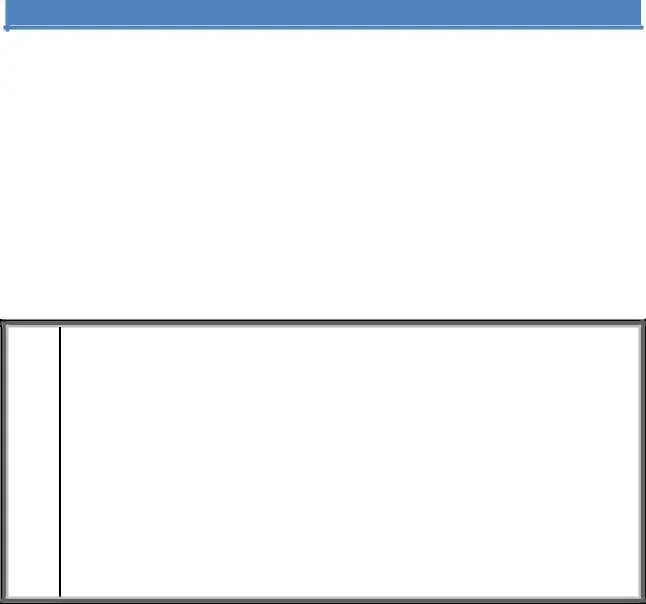
THE RCRA HAZARDOUS WASTE PART A PERMIT APPLICATION
INTRODUCTION
The Resource Conservation and Recovery Act (RCRA) requires anyone who owns or operates a facility where hazardous waste is treated, stored, or disposed to have a RCRA hazardous waste permit issued by the U.S. Environmental Protection Agency (EPA). This booklet is designed to help you determine if you are subject to RCRA hazardous waste permitting requirements. The instructions contained in this booklet will assist you in starting the permitting process by completing and submitting a RCRA Hazardous Waste Part A Permit Application [EPA Form 8700-23] (Part A Permit Application) or in modifying your hazardous waste permit by submitting a revised application.
There are two parts to a RCRA Hazardous Waste Permit Application – Part A and Part B. Part A of the RCRA Hazardous Waste Permit Application consists of EPA Form 8700-23 (includes both the RCRA Subtitle C Site Identification Form and the Hazardous Waste Permit Information Form), along with maps, drawings, and photographs, as required by 40 CFR 270.13. Part B of the RCRA hazardous waste permit application contains detailed, site-specific information. There is no form for the Part B Permit Application; rather, the Part B Permit Application must be submitted in narrative form and contain the information described in applicable sections of 40 CFR 270.14 through 270.27.
Although this booklet contains information and instructions for completing a Part A Permit Application, it should not be considered a substitute for the regulations in Title 40 of the Code of Federal Regulations (40 CFR). Rather, this booklet serves as a supplement to the regulations and provides additional information not contained in 40 CFR. As an owner or operator of a hazardous waste treatment, storage, or disposal facility, you are responsible for learning and complying with all the requirements that apply to you and the operations at your facility.
In addition, remember that this booklet and the regulations in 40 CFR address only the Federal hazardous waste program. Many States may have hazardous waste permitting requirements that differ from the Federal requirements; those States may use EPA Form 8700-23 for the Part A Permit Application submission or they may use a similar State form that requires information not requested in the EPA form. Again, it is your responsibility to make sure that you have completed and submitted all forms required under the Federal or your State program.
1 |
(Go to Table of Contents) |
|
The RCRA Hazardous Waste Part A Permit Application (continued)
WHAT’S NEW
Below are a list of changes to the RCRA Hazardous Waste Part A Permit Application Instructions and Forms.
CLARIFIED THE DEFINITION OF LARGE QUANTITY GENERATOR (LQG)
Although current RCRA regulations do not specifically define the term “large quantity generator” (LQG), they do define the terms “conditionally exempt small quantity generator” (CESQG) and “small quantity generator “(SQG). Thus, a LQG is a generator that is not a CESQG or SQG. For purposes of clarity, the definition of LQG has been revised to describe all those situations where a generator would be a LQG.
CLARIFIED THE DEFINITION OF SMALL QUANTITY GENERATOR (SQG)
A SQG is defined at 40 CFR 260.10 as a site that generates less than 1,000 kilograms (kg; 2,200 pounds [lbs]) of hazardous waste in a calendar month. However, there are other situations where a generator could generate small amounts of acute hazardous waste listed in sections 261.31 or 261.33(e); and any residues or contaminated soil, waste, or other debris resulting from the cleanup of a spill, into or on any land or water, of any acute hazardous wastes listed in sections 261.31 or 261.33(e) and still maintain its regulatory status as a SQG. Therefore, for purposes of clarity, the definition of SQG has been revised to describe all those situations where a generator would continue to be a SQG. The EPA plans to make the appropriate conforming change to the outdated definition of SQG at 40 CFR 260.10 in the future.
CLARIFIED THE DEFINITION OF CONDITIONALLY EXEMPT SMALL QUANTITY GENERATOR (CESQG)
A CESQG is defined at 40 CFR 261.5(a) as a site that generates less than or equal to 100 kg (220 lbs) of hazardous waste in a calendar month. However, as found in 40 CFR 261.5(e), a generator also may generate small amounts of acute hazardous waste listed in sections 261.31 or 261.33(e); and any residues or contaminated soil, waste, or other debris resulting from the cleanup of a spill, into or on any land or water, of any acute hazardous wastes listed in sections 261.31, or 261.33(e) and still maintain its regulatory status as a CESQG. Therefore, for purposes of clarity, the definition of CESQG has been revised to describe all those situations where a generator would continue to be a CESQG.
WHERE TO GET HELP
We realize that the regulations are complex. Although we are not providing reprints of the 40 CFR regulations in this booklet, copies of the Federal regulations are available from the EPA (see below). A list of State and EPA Regional Office addresses, contact names, telephone numbers, and e-mail addresses are located at: http://www.epa.gov/osw/inforesources/data/form8700/contact.pdf.
In addition to those contacts, there are several other sources available to help with your questions and provide information on EPA regulations:
2 |
(Go to Table of Contents) |
|
The RCRA Hazardous Waste Part A Permit Application (continued)
RCRA FREQUENTLY ASKED QUESTIONS
This allows users to find answers to commonly asked questions that cover a wide range of RCRA issues and topics. Find at: http://waste.supportportal.com/ics/support/default.asp?deptID=23023.
RCRA ONLINE
The RCRA Online database is designed to enable users to locate documents, including publications and other outreach materials that cover a wide range of RCRA issues and topics. Find at: http://www.epa.gov/rcraonline.
RCRA REGULATIONS
The Federal regulations can be found at: http://www.gpo.gov/fdsys/.
COMPLIANCE ASSISTANCE CENTERS
The EPA has sponsored partnerships with industry, academic institutions, environmental groups, and other agencies to launch sector-specific Compliance Assistance Centers (Centers). Each Center addresses real world issues in understandable language for you to understand Federal environmental requirements and how to save money through pollution prevention techniques. Visit the Compliance Assistance Centers at: http://www.assistancecenters.net.
EPA NATIONAL COMPLIANCE ASSISTANCE CLEARINGHOUSE
The Compliance Assistance Clearinghouse is a comprehensive source of compliance assistance information and resources. Use links to Federal, State, local, and other compliance assistance providers
to find the tools you need. Visit the Compliance Assistance Clearinghouse at: http://www.epa.gov/compliance/assistance/index.html.
EPA SMALL BUSINESS OMBUDSMAN OFFICE
1-800-368-5888.
YOUR TRADE ASSOCIATION
EXISTING FACILITIES
Existing hazardous waste management facilities are those hazardous waste treatment, storage, or disposal facilities (TSDFs) which were in operation or for which construction had commenced on or before November 19, 1980, or which were in existence on the effective date of the statutory or regulatory amendments that render the facility subject to the requirement to obtain a RCRA permit. RCRA established a procedure for obtaining interim status that allows these existing facilities to continue operating until a final hazardous waste permit is issued.
3 |
(Go to Table of Contents) |
|
The RCRA Hazardous Waste Part A Permit Application (continued)
You must submit a Part A Permit Application completing all forms included in this booklet. If you do not file a Notification of RCRA Subtitle C Activity and complete the Part A Permit Application by the deadlines specified in the “WHEN SHOULD I FILE MY PERMIT APPLICATION?” section of these instructions, you will be required by law to halt your operations until a RCRA hazardous waste permit is issued.
Facility owners or operators with interim status are treated as having been issued a permit until the EPA reviews the Part B Permit Application and issues a RCRA hazardous waste permit. You may submit your Part B Permit Application voluntarily; however, you are not required to submit it until it is requested by the EPA. You will then have up to six months to submit the Part B Permit Application.
NEW FACILITIES
New hazardous waste management facilities are those hazardous waste TSDFs which were not in operation or for which construction had not commenced on or before November 19, 1980. Owners or operators of new hazardous waste management facilities must submit both Parts A and B of the RCRA Hazardous Waste Permit Application at least 180 days before physical construction of the facility is expected to commence. In addition, these owners or operators are not allowed to begin physical construction of the new facility or to treat, store, or dispose of hazardous wastes until receiving a RCRA hazardous waste permit. As such, new facilities do not receive interim status. In addition, new facilities are those facilities that are newly subject to the requirement to obtain a RCRA hazardous waste permit (e.g., through the EPA’s promulgation of a new hazardous waste listing). An application for a permit may be submitted any time after promulgation of those standards in 40 CFR subjecting the facility to hazardous waste permitting requirements.
Most State governments are authorized by the EPA to administer hazardous waste management programs in lieu of the Federal RCRA program. You should contact your State hazardous waste management agency to determine any additional State requirements. You will need to comply with the specific permit application requirements of that State.
The following instructions provide specific information for completing and submitting a Part A Permit Application using the forms included in this booklet. The instructions also provide general information for completing a Part B Permit Application. If, after reading the instructions, you have any questions regarding the RCRA hazardous waste permit application process, contact your State Representative who can answer your questions and help you understand the Federal and State requirements that apply to you. A list of State contacts is available at: http://www.epa.gov/osw/inforesources/data/form8700/contact.pdf.
FIRST PART A SUBMISSION
Both new and existing facilities that treat, store, or dispose of regulated hazardous waste are required to submit a Part A Permit Application in accordance with the deadlines set forth in the “WHEN SHOULD I FILE MY PERMIT APPLICATION?” section of these instructions. Owners or operators of facilities that have not previously submitted a Part A Permit Application will need to submit a permit application for the first time. Examples of facilities making their first Part A submission are new facilities or existing
4 |
(Go to Table of Contents) |
|
